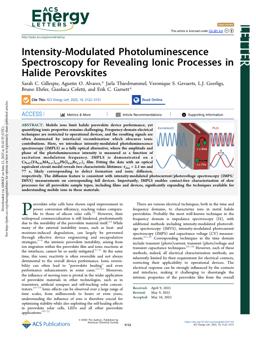2025-06-10
Intensity-Modulated Photoluminescence Spectroscopy for Revealing Ionic Processes in Halide Perovskites
Publication
Publication
ACS Energy Lett. , Volume 10 - Issue 7 p. 3122- 3131
Mobile ions limit halide perovskite device performance, yet quantifying ionic properties remains challenging. Frequency-domain electrical techniques are restricted to operational devices, and the resulting signals are often dominated by interfacial recombination which obscures ionic contributions. Here, we introduce intensity-modulated photoluminescence spectroscopy (IMPLS) as a fully optical alternative, where the amplitude and phase of the photoluminescence intensity is measured as a function of excitation modulation frequency. IMPLS is demonstrated on a Cs0.07(FA0.83MA0.17)0.93Pb(I0.83Br0.17)3 film. Fitting the data with an optical equivalent circuit model reveals two characteristic lifetimes: τchar = 2.1 ms and 77 s, likely corresponding to defect formation and ionic diffusion, respectively. The diffusion feature is consistent with intensity-modulated photocurrent/photovoltage spectroscopy (IMPS/IMVS) measurements on corresponding full devices. Importantly, IMPLS enables contact-free characterization of slow processes for all perovskite sample types, including films and devices, significantly expanding the techniques available for understanding mobile ions in these materials.
| Additional Metadata | |
|---|---|
| ACS | |
| European Research Council (ERC) , Netherlands Organisation for Scientific Research (NWO) , Dutch Ministry of Economic Affairs and Climate Policy , Ministry of Climate Policy and Green Growth | |
| doi.org/10.1021/acsenergylett.5c01102 | |
| ACS Energy Lett. | |
| Organisation | Nanoscale Solar Cells |
|
Garnett, E., Gillespie, S., Alvarez, A., Thiesbrummel, J., Gevaerts, V., Geerligs, L. J., … Coletti, G. (2025). Intensity-Modulated Photoluminescence Spectroscopy for Revealing Ionic Processes in Halide Perovskites. ACS Energy Lett., 10(7), 3122–3131. doi:10.1021/acsenergylett.5c01102 |
|
